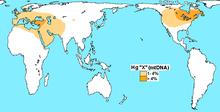Haplogroup X (mtDNA)
| Haplogroup X | |
|---|---|
 |
|
| Possible time of origin | 30,000 YBP |
| Ancestor | N |
| Descendants | X1, X2 |
| Defining mutations | 73, 7028, 11719, 12705, 14766, 16189, 16223, 16278 |
Haplogroup X is a (mtDNA) haplogroup found in the Americas, Europe, Western Asia, North Africa and the Horn of Africa.
The genetic sequences of haplogroup X diverged originally from haplogroup N, and subsequently further diverged thousands of years ago to two sub-groups, X1 and X2.
Haplogroup X is found in approximately 7% of native Europeans, and 3% of all Native Americans from North America.
Overall, haplogroup X is found in around 2% of the population of Europe, the Near East and North Africa. It is especially common among Egyptians inhabiting El-Hayez oasis (14.3%).
Sub-group X1 is much less frequent, and is largely restricted to North Africa, the Horn of Africa and the Near East.
Sub-group X2 appears to have undergone extensive population expansion and dispersal around or soon after the Last Glacial Maximum, about 21,000 years ago. It is more strongly present in the Near East, the Caucasus, and Southern Europe and somewhat less strongly present in the rest of Europe. Particular concentrations appear in Georgia (8%), Orkney (in Scotland) (7%), and amongst the Israeli Druze community (27%). Subclades X2a and X2g are found in North America, but are not present in native South Americans. Many of the early carriers of haplogroup X2a were found in eastern maritime Canada, a prime theoretical landing location for Solutreans. This encouraged adherents to the Solutrean hypothesis. However, more recent discoveries of haplogroup X2a and subgroups have been more widely geographically dispersed. Neither is there a path or ancestral form of X2a found in Europe or the Middle East.
...
Wikipedia
